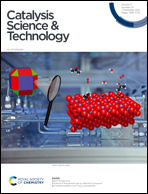Influence of the particle size on selective 2-propanol gas-phase oxidation over Co3O4 nanospheres†
Abstract
Co3O4 nanospheres with a mean diameter of 19 nm were applied in the selective oxidation of 2-propanol to acetone in the gas phase. Compared with 9 nm spheres, the 19 nm spheres exhibited superior catalytic activity and stability with 100% selectivity to acetone up to 500 K. Transmission electron microscopy, N2 physisorption, 2-propanol and O2 temperature-programmed desorption, and 2-propanol temperature-programmed surface reaction in O2 were applied to characterize the bulk and surface properties. Despite the smaller specific surface area (35 m2 g−1), an increased 2-propanol adsorption capacity was observed for the larger nanospheres ascribed to a preferential (110) surface orientation. Temperature-programmed oxidation experiments after reaction showed multilayer coke deposition and severe reduction of the Co3O4 surface, but excellent stability was maintained at 430 K using the 19 nm spheres in a steady-state oxidation experiment for 100 h with only 10% loss of the initial activity. The good agreement of the 2-propanol decomposition profiles indicates that the superior activity is caused by the enhanced interaction of the larger nanospheres with O2. A Mars–van Krevelen mechanism on the (110) surface was identified by density functional theory calculations with a Hubbard U term, favoring faster reoxidation compared with the (100) surface predominantly exposed by the 9 nm spheres.



 Please wait while we load your content...
Please wait while we load your content...